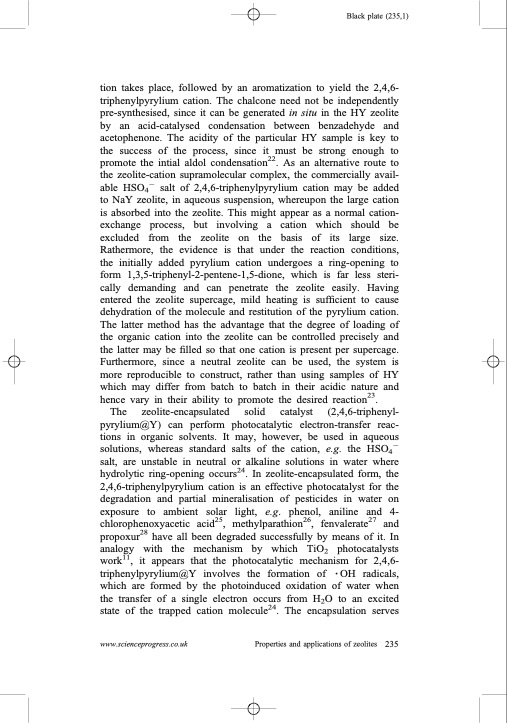
PDF Publication Title:
Text from PDF Page: 013
Black plate (235,1) tion takes place, followed by an aromatization to yield the 2,4,6- triphenylpyrylium cation. The chalcone need not be independently pre-synthesised, since it can be generated in situ in the HY zeolite by an acid-catalysed condensation between benzadehyde and acetophenone. The acidity of the particular HY sample is key to the success of the process, since it must be strong enough to promote the intial aldol condensation22. As an alternative route to the zeolite-cation supramolecular complex, the commercially avail- able HSO4 salt of 2,4,6-triphenylpyrylium cation may be added to NaY zeolite, in aqueous suspension, whereupon the large cation is absorbed into the zeolite. This might appear as a normal cation- exchange process, but involving a cation which should be excluded from the zeolite on the basis of its large size. Rathermore, the evidence is that under the reaction conditions, the initially added pyrylium cation undergoes a ring-opening to form 1,3,5-triphenyl-2-pentene-1,5-dione, which is far less steri- cally demanding and can penetrate the zeolite easily. Having entered the zeolite supercage, mild heating is sufficient to cause dehydration of the molecule and restitution of the pyrylium cation. The latter method has the advantage that the degree of loading of the organic cation into the zeolite can be controlled precisely and the latter may be filled so that one cation is present per supercage. Furthermore, since a neutral zeolite can be used, the system is more reproducible to construct, rather than using samples of HY which may differ from batch to batch in their acidic nature and hence vary in their ability to promote the desired reaction23. The zeolite-encapsulated solid catalyst (2,4,6-triphenyl- pyrylium@Y) can perform photocatalytic electron-transfer reac- tions in organic solvents. It may, however, be used in aqueous solutions, whereas standard salts of the cation, e.g. the HSO4 salt, are unstable in neutral or alkaline solutions in water where hydrolytic ring-opening occurs24. In zeolite-encapsulated form, the 2,4,6-triphenylpyrylium cation is an effective photocatalyst for the degradation and partial mineralisation of pesticides in water on exposure to ambient solar light, e.g. phenol, aniline and 4- chlorophenoxyacetic acid25, methylparathion26, fenvalerate27 and propoxur28 have all been degraded successfully by means of it. In analogy with the mechanism by which TiO2 photocatalysts work11, it appears that the photocatalytic mechanism for 2,4,6- triphenylpyrylium@Y involves the formation of ?OH radicals, which are formed by the photoinduced oxidation of water when the transfer of a single electron occurs from H2O to an excited state of the trapped cation molecule24. The encapsulation serves www.scienceprogress.co.uk Properties and applications of zeolites 235PDF Image | Properties and applications of zeolites

PDF Search Title:
Properties and applications of zeolitesOriginal File Name Searched:
003685010x12800828155007.pdfDIY PDF Search: Google It | Yahoo | Bing
CO2 Organic Rankine Cycle Experimenter Platform The supercritical CO2 phase change system is both a heat pump and organic rankine cycle which can be used for those purposes and as a supercritical extractor for advanced subcritical and supercritical extraction technology. Uses include producing nanoparticles, precious metal CO2 extraction, lithium battery recycling, and other applications... More Info
Heat Pumps CO2 ORC Heat Pump System Platform More Info
| CONTACT TEL: 608-238-6001 Email: greg@infinityturbine.com | RSS | AMP |